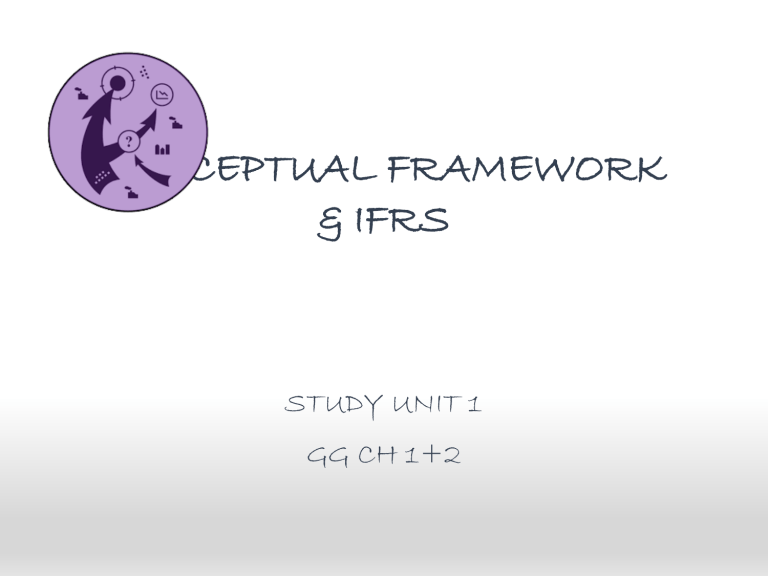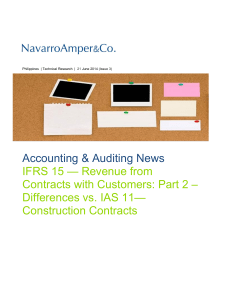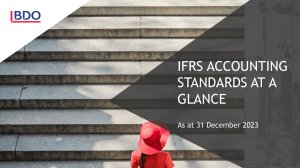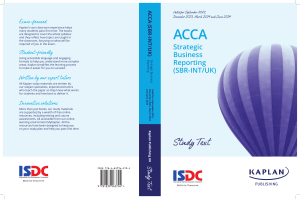
CONCEPTUAL FRAMEWORK & IFRS STUDY UNIT 1 GG CH 1+2 OUTCOMES • Name the objective of general-purpose financial reporting • Name and discuss the users of financial statements and their needs for financial information • Discuss the qualitative characteristics, underlying assumption and concepts that are necessary for the preparation and presentation of financial statements • Discuss the elements of financial statements, as well as the recognition, derecognition and measurement thereof PILLARS OF ACCOUNTING CONCEPTUAL FRAMEWORK (NOT A STANDARD) IAS 1 PRESENTATION OF FINANCIAL STATEMENTS OTHER IAS STANDARDS (2–41) IFRS STANDARDS DIFFERENCE BETWEEN IAS & IFRS 1966 IAS begins 1967 (England, Wales, America, Canada) Accounts International Study Group publishes documents IASB adopts IAS; adds IFRS (IFRS > IAS) 2001 IASC IASB 1973 Changed to IASC 1973-2000 IAS 1-41 WHAT IS THE CONCEPTUAL FRAMEWORK? Basic concepts for preparing & presenting financial statements for external users Remember: It’s only a framework. It’s not a standard. To oncoming STANDARDS CF deals with the following 1. 2. 3. Objective of general- purpose financial reporting Qualitative characteristics of useful financial information Financial statements & the reporting entity 6. 7. 4. 5. Recognition and derecognition 8. Concepts of capital & capital maintenance 1. Objective of general-purpose financial reporting Financial information Primary users: Reporting entity • • • Existing & potential investors Lenders Other creditors 2. Qualitative characteristics FUNDAMENTAL ENHANCING Relevance Comparability AND Verifiability Faithful representation Understandability Timeliness Fundamental characteristics Relevance Faithful representation Completeness Capable of making a difference in a decision Neutrality Free from error Enhancing characteristics Comparability Verifiability Timeliness Understandability 3a. Financial statements Financial performance Financial position Other SPLOCI SFP Notes Cash flows Accrual accounting Comply with definitions and recognition criteria Recognise transactions when they occur 3b. Reporting entity Any entity who is required to or chooses to prepare financial statements Single entity Portion of an entity More than one entity 4. Elements of financial statements Financial performance Financial position 5. Recognition of elements 2 requirements Meet element definition Must result in BOTH: Relevant information Faithful representation 5. Recognition of elements Relevance is influenced by … Existence uncertainty e.g. dispute Outcome uncertainty e.g. plant crops 5. Recognition of elements Faithful representation is influenced by … Measurement uncertainty make estimates Recognition uncertainty element may not be recognised, but disclose in notes 6. Derecognition of elements Assets Liabilities when the entity loses control of all or part of the asset when the entity no longer has a present obligation for all or part of the liability 6. Measurement bases Historical cost Transaction price, i.e. price at acquisition Current value Reflects conditions at measurement date Fair value – market’s current expectations Value-in-use – entity’s current expectations Current cost – current replacement cost 7. Presentation & Disclosure Requirements for effective communication Focus on objectives & principles Classification Group similar items Separate dissimilar items Aggregation Don’t obscure information 8. Capital & Capital maintenance Financial capital Physical capital = Net assets/equity = Production capacity Profit = Closing net assets > Opening net assets Profit = Closing production capacity > Opening production capacity For more information, refer to your textbook Work through all examples in your textbook Homework: Consult semester programme











